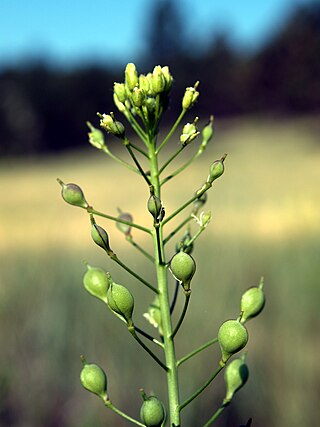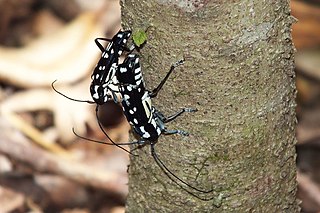
Camelina is a genus within the flowering plant family Brassicaceae. The Camelina species, commonly known as false flax, are native to Mediterranean regions of Europe and Asia. Most species of this genus have been little studied, with the exception of Camelina sativa, historically cultivated as an oil plant. Heinrich Johann Nepomuk von Crantz was the first botanist to use the genus Camelina in his classification works in 1762.

Camelina sativa is a flowering plant in the family Brassicaceae usually known as camelina, gold-of-pleasure, or false flax, but also occasionally as wild flax, linseed dodder, German sesame, or Siberian oilseed. It is native to Europe and areas of Central Asia, but cultivated as an oilseed crop mainly in Europe and in North America. It is not related to true flax, in the family Linaceae.
An EPPO code, formerly known as a Bayer code, is an encoded identifier that is used by the European and Mediterranean Plant Protection Organization (EPPO), in a system designed to uniquely identify organisms – namely plants, pests and pathogens – that are important to agriculture and crop protection. EPPO codes are a core component of a database of names, both scientific and vernacular. Although originally started by the Bayer Corporation, the official list of codes is now maintained by EPPO.

Glenealy is one of the few roads or streets without a suffix in Hong Kong. Located in the Mid-Levels on the Hong Kong Island, Hong Kong, it starts from Ice House Street and goes uphill to Hong Kong Zoological and Botanical Gardens, across Robinson Road and ends at Hornsey Road and Conduit Road.
Camelina oil or False flax oil is a pressed seed oil, derived from the Camelina sativa or false flax, also called gold of pleasure. False flax has long been grown in Europe, and its oil used as a lamp oil until the 18th century. In recent times, it has been explored for use in cosmetic and skin care products. It has a high content of omega-3 and is used as a food supplement by some cultures. It is registered under the name "Olej rydzowy tradycyjny" as a Traditional Speciality Guaranteed product in the European Union and the United Kingdom.

The R752 road is a regional road in County Wicklow, Ireland. From its junction with the R772 in Rathnew on the outskirts of Wicklow Town it takes a generally south-westerly route to its junction with the R747 in the village of Woodenbridge, where it terminates. The road is 26 km (16 mi) long.

Glenealy is a village in County Wicklow, Ireland. It is 8 km (5 mi) west of Wicklow Town, on the R752 road. The Dublin–Rosslare railway line also passes through the village. The village is in a civil parish of the same name.

Camelina microcarpa is a species of flowering plant in the mustard family known by several common names, including littlepod false flaxlesser gold-of-pleasure and small seed false flax. It is native to Europe and Asia, and it is common across the globe as an introduced species and sometimes a noxious weed. It is known as a weed of grain crops such as wheat and rye. This is an erect annual herb producing a branched or unbranched stem 30 centimeters to one meter in height. It is sometimes coated thinly in hairs, particularly on the lower part. The leaves are lance-shaped to oblong. The upper part of the stem is occupied by an inflorescence of many pale yellow flowers. They yield plump oblong to rounded fruits, each under a centimeter long and held at the tip of a short pedicel.

Hydrocarbon plants are plants that follow certain metabolic pathways that produce hydrocarbon products similar to petroleum. These hydrocarbon products are called terpenoids. The plants that produce terpenoids in large enough quantities to be harvested can be as big as trees or as small as single-cell algae. The family Euphorbiaceae has been studied in detail by Dr. Melvin Calvin, Nobel Laureate, and discoverer of the Calvin Cycle. One particular tree of the genus Hevea, more commonly known as the rubber tree, is probably the most famous hydrocarbon plant, supplying an estimated one third of the world’s rubber demand. It is still not as quick and cheap to make as petroleum-based rubber, which is why it does not occupy a larger portion of the market. Hevea naturally produces a latex substance which can tapped by cutting into the tree, and the latex can then be processed into rubber.
The 2005–06 All-Ireland Senior Club Hurling Championship was the 36th staging of the All-Ireland Senior Club Hurling Championship, the Gaelic Athletic Association's premier inter-county club hurling tournament. The championship began on 30 October 2005 and ended on 17 March 2006.
Glenealy Hurling Club is a Gaelic Athletic Association club located in the parish of Glenealy and Ashford in County Wicklow, Ireland. The club was founded in 1885 as a football club but switched codes to the game of hurling in the early 1920s.

Global Clean Energy Holdings (OTC:GCEH) is a Southern California-based renewable energy company with interests in the production and commercialization of non-food-based feedstocks used for the production of biofuels, biomass, and renewable chemicals. It was founded in 2007.
Yield10 Bioscience is a company developing new technologies to achieve improvements in crop yield to enhance global food security.

Sustainable Oils is a renewable fuels company specializing in the research and production of Camelina, the only advanced biofuels feedstock with United States Department of Agriculture, Environmental Protection Agency, and Food and Drug Administration (FDA) regulatory approvals. Oil extracted from Camelina seeds can be processed into a number of renewable products including renewable jet fuel, green diesel, biodiesel, green plastics and renewable oleochemicals. The biomass that remains after oil extraction, generally referred to seedcake or meal, can be used as nutrient-rich animal feed. Camelina offers several advantages over traditional biofuel feedstocks like soy and corn, such as competitive oil yields and shorter growing seasons. Sustainable Oils has its primary operations in the state of Montana and is headquartered in Great Falls.
Imelcana camelina is a species of moth of the family Tortricidae which is endemic to Venezuela.

Glenea is a genus of longhorn beetles belonging to the family Cerambycidae, subfamily Lamiinae.

Glenea venus is a species of beetle in the family Cerambycidae. It was described by James Thomson in 1865. It is known from Papua New Guinea, Australia and Indonesia.
Glenea glaucescens is a species of beetle in the family Cerambycidae. It was described by Per Olof Christopher Aurivillius in 1903 and is known from Sulawesi.

Glenea dimidiata is a species of beetle in the family Cerambycidae. It was described by Johan Christian Fabricius in 1801. It is known from Malaysia and Indonesia.

Camelina alyssum is a species of flowering plant belonging to the family Brassicaceae. Its native range is Europe to Caucasus.











